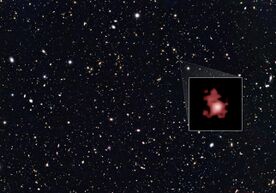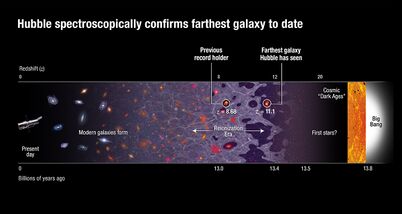Astronomy:GN-z11
| GN-z11 | |
|---|---|
 GN-z11 superimposed on an image from the GOODS-North survey | |
| Observation data (J2000[1] epoch) | |
| Constellation | Ursa Major[1] |
| Right ascension | 12h 36m 25.46s[1] |
| Declination | +62° 14′ 31.4″[1] |
| Redshift | 10.6034±0.0013[2] |
| Helio radial velocity | 295,050 ± 119,917 km/s (183,336 ± 74,513 mi/s)[3] |
| Distance |
|
| Apparent magnitude (V) | 25.8H |
| Characteristics | |
| Type | Irregular |
| Mass | ~1×109[4] M☉ |
| Size | 4,000 ± 2,000 ly (1,200 ± 610 pc)[4] |
| Apparent size (V) | 0.6arcsec[4] |
| Other designations | |
| GN-z10-1,[4] GNS-JD2[3] | |
GN-z11 is a high-redshift galaxy found in the constellation Ursa Major. It is among the farthest known galaxies from Earth ever discovered.[5][6] The 2015 discovery was published in a 2016 paper headed by Pascal Oesch and Gabriel Brammer (Cosmic Dawn Center). Up until the discovery of JADES-GS-z13-0 in 2022 by the James Webb Space Telescope, GN-z11 was the oldest and most distant known galaxy yet identified in the observable universe,[7] having a spectroscopic redshift of z = 10.957, which corresponds to a proper distance of approximately 32 billion light-years (9.8 billion parsecs).[8][note 1] Data published in 2024 established that the galaxy contains the most distant, and therefore earliest, black hole known in the universe.[9][10]
The object's name is derived from its location in the GOODS-North field of galaxies and its high cosmological redshift number (GN + z11).[11] It is observed as it existed 13.4 billion years ago, just 400 million years after the Big Bang;[4][12][13] as a result, its distance is sometimes inappropriately[14] reported as 13.4 billion light-years, its light-travel distance measurement.[15][16]
In early 2023, JWST observed the galaxy and reported a definitive redshift of Z=10.6034 ± 0.0013.[2]
The galaxy has such a high redshift that its angular diameter distance is actually less than that of some galaxies with lower redshift. This means that the ratio of its angular size to its size in light-years is greater.
Discovery
The galaxy was identified by a team studying data from the Hubble Space Telescope's Cosmic Assembly Near-infrared Deep Extragalactic Legacy Survey (CANDELS) and Spitzer Space Telescope's Great Observatories Origins Deep Survey-North (GOODS-North).[17][18] The research team used Hubble's Wide Field Camera 3 to measure the distance to GN-z11 spectroscopically, measuring the redshift caused by the expansion of the universe.[19] The findings, which were announced in March 2016, revealed the galaxy to be farther away than originally thought, at the distance limit of what the Hubble Telescope can observe. GN-z11 is around 150 million years older than the previous record-holder EGSY8p7,[11] and is observed (shortly after but) "very close to the end of the so-called Dark Ages of the universe",[19] and (during but) "near the very beginning" of the reionization era.[17]
Compared with the Milky Way galaxy, GN-z11 is 1⁄25 of the size, has 1% of the mass, and is forming new stars approximately twenty times as fast.[19] With a stellar age estimated at 40 million years, it appears the galaxy formed its stars relatively rapidly.[4] The fact that a galaxy so massive existed so soon after the first stars started to form is a challenge to some current theoretical models of the formation of galaxies.[17][19]
See also
Notes
- ↑ At first glance, the distance of 32 billion light-years (9.8 billion parsecs) might seem impossibly far away in a Universe that is only 13.8 billion (short scale) years old, where a light-year is the distance light travels in a year, and where nothing can travel faster than the speed of light. However, because of the expansion of the universe, the distance of 2.66 billion light-years between GN-z11 and the Milky Way at the time when the light was emitted increased by a factor of (z+1)=12.1 to a distance of 32 billion light-years during the 13.4 billion years it has taken the light to reach us. See: Size of the observable universe, Misconceptions about the size of the observable universe, Measuring distances in expanding space, and Ant on a rubber rope.
References
- ↑ 1.0 1.1 1.2 1.3 "Hubble Team Breaks Cosmic Distance Record - Fast Facts". HubbleSite. 3 March 2016. http://hubblesite.org/newscenter/archive/releases/2016/07/fastfacts/.
- ↑ 2.0 2.1 Bunker, Andrew J. et al. (2023). "JADES NIRSpec Spectroscopy of GN-z11: Lyman- α emission and possible enhanced nitrogen abundance in a z = 10.60 luminous galaxy". Astronomy & Astrophysics 677: A88. doi:10.1051/0004-6361/202346159.
- ↑ 3.0 3.1 "[BIG2010 GNS-JD2"]. SIMBAD. Centre de données astronomiques de Strasbourg. http://simbad.u-strasbg.fr/simbad/sim-basic?Ident=%5BBIG2010%5D+GNS-JD2.
- ↑ 4.0 4.1 4.2 4.3 4.4 4.5 Oesch, P. A. et al. (March 2016). "A Remarkably Luminous Galaxy at z=11.1 Measured with Hubble Space Telescope Grism Spectroscopy". The Astrophysical Journal 819 (2): 129. doi:10.3847/0004-637X/819/2/129. Bibcode: 2016ApJ...819..129O.
- ↑ Gohd, Chelsea (21 December 2020). "Scientists think they've spotted the farthest galaxy in the universe". Space.com. https://www.space.com/oldest-most-distant-galaxy-discovery.
- ↑ O'Neill, Mariclaire; Whitehead, Nadia (7 April 2022). "Scientists Have Spotted the Farthest Galaxy Ever". Center for Astrophysics. https://www.cfa.harvard.edu/news/scientists-have-spotted-farthest-galaxy-ever.
- ↑ Klotz, Irene (3 March 2016). "Hubble Spies Most Distant, Oldest Galaxy Ever". Seeker (Discovery, Inc.). https://www.seeker.com/hubble-spies-most-distant-oldest-galaxy-ever-1770971428.html.
- ↑ Jiang, Linhua (January 2021). "Evidence for GN-z11 as a luminous galaxy at redshift 11". Nature Astronomy 5: 256–261. doi:10.1038/s41550-020-01275-y. Bibcode: 2021NatAs...5..256J.
- ↑ Robert Lea (January 17, 2024). "James Webb Space Telescope discovers oldest and most distant black hole ever seen". https://www.space.com/james-webb-space-telescope-oldest-black-hole.
- ↑ Joe Pinkstone (January 17, 2024). "Oldest black hole ever seen challenges what we know about their formation". The Telegraph. https://www.telegraph.co.uk/news/2024/01/17/oldest-black-hole-challenges-formation-nasa-cambridge-bang/.
- ↑ 11.0 11.1 "Hubble Team Breaks Cosmic Distance Record". NASA. 3 March 2016. https://www.nasa.gov/feature/goddard/2016/hubble-team-breaks-cosmic-distance-record/.
- ↑ Amos, Jonathan (3 March 2016). "Hubble sets new cosmic distance record". BBC News. https://www.bbc.com/news/science-environment-35721734.
- ↑ Griffin, Andrew (4 March 2016). "Most distant object in the universe spotted by Hubble Space Telescope, shattering record for the farthest known galaxy". The Independent. https://www.independent.co.uk/news/science/most-distant-object-in-the-universe-spotted-by-hubble-space-telescope-shattering-record-for-the-a6911096.html.
- ↑ Wright, Edward L. (2 August 2013). "Why the Light Travel Time Distance should not be used in Press Releases". University of California, Los Angeles. http://www.astro.ucla.edu/~wright/Dltt_is_Dumb.html.
- ↑ Borenstein, Seth (3 March 2016). "Astronomers Spot Record Distant Galaxy From Early Cosmos". Associated Press. http://bigstory.ap.org/article/6c9dcadf6d5f4741b010da09f5841b6f/astronomers-spot-record-distant-galaxy-early-cosmos.
- ↑ "GN-z11: Astronomers push Hubble Space Telescope to limits to observe most remote galaxy ever seen". Australian Broadcasting Corporation. 3 March 2016. http://www.abc.net.au/news/2016-03-04/hubble-space-telescope-observes-most-remote-galaxy-ever-seen/7219846.
- ↑ 17.0 17.1 17.2 "Hubble breaks cosmic distance record". 3 March 2016. http://www.spacetelescope.org/news/heic1604/.
- ↑ "Hubble Team Breaks Cosmic Distance Record". 3 March 2016. http://hubblesite.org/newscenter/archive/releases/2016/07/full/.
- ↑ 19.0 19.1 19.2 19.3 Shelton, Jim (3 March 2016). "Shattering the cosmic distance record, once again". Yale University. http://news.yale.edu/2016/03/03/shattering-cosmic-distance-record-once-again.
| Records | ||
|---|---|---|
| Preceded by EGSY8p7 |
Most distant known astronomical object 2016–2022 |
Succeeded by HD1 |
| Preceded by EGSY8p7 |
Most distant known galaxy 2016–2022 |
Succeeded by HD1 |
 |





